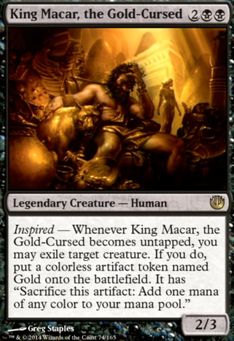
A Lonely Existence *PRIMER*
Commander / EDH Artifact Bracket 3 Casual Control Exile Mono-Black Multiplayer
Artifact (24)
- 1x Arcane Signet
- 1x Caged Sun
- 1x Clock of Omens
- 1x Jet Medallion
- 1x Lightning Greaves
- 1x Liquimetal Torque
- 1x Mana Vault
- 1x Mox Opal
- 1x Paradise Mantle
- 1x Patriar's Seal
- 1x Relic of Legends
- 1x Sensei's Divining Top
- 1x Shadowspear
- 1x Sol Ring
- 1x Springleaf Drum
- 1x Swiftfoot Boots
- 1x Sword of the Paruns
- 1x The One Ring
- 1x Thornbite Staff
- 1x Thousand-Year Elixir
- 1x Throne of Eldraine
- 1x Umbral Mantle
- 1x Voltaic Key
- 1x Whip of Erebos
Sorcery (7)
Creature (21)
- 1x Ancient Brass Dragon
- 1x Archfiend of Depravity
-
1x
Archon of Cruelty

- 1x Avatar of Woe
- 1x Bloodgift Demon
- 1x Crypt Ghast
- 1x Disciple of the Vault
- 1x Indulgent Tormentor
- 1x Karn, Silver Golem
- 1x Marionette Master
- 1x Metalworker
- 1x Nadier's Nightblade
- 1x Pain Seer
- 1x Palladium Myr
- 1x Royal Assassin
- 1x Servant of Tymaret
- 1x Sheoldred, Whispering One
- 1x Skirsdag High Priest
- 1x Valgavoth, Terror Eater
- 1x Visara the Dreadful
- 1x Voltaic Construct
Instant (7)
- 1x Dark Ritual
- 1x Deadly Rollick
- 1x Hero's Downfall
- 1x Sudden Spoiling
- 1x Tragic Slip
- 1x Vampiric Tutor
- 1x Withering Torment
Enchantment (4)
Commander (1)
Land (35)
- 1x Arcane Lighthouse
- 1x Blast Zone
-
1x
Bloodstained Mire

- 1x Bojuka Bog
- 1x Cabal Coffers
- 1x Cabal Stronghold
- 1x Inventors' Fair
- 1x Marsh Flats
- 1x Maze of Ith
- 1x Mortuary Mire
- 1x Nykthos, Shrine to Nyx
- 1x Polluted Delta
- 18x Swamp
- 1x Terrain Generator
- 1x Urborg, Tomb of Yawgmoth
- 1x Vault of Whispers
- 1x Verdant Catacombs
- 1x War Room
Planeswalker (1)
Suggestions
Updates Add
Comments View Archive
Attention! Complete Comment Tutorial! This annoying message will go away once you do!
Important! Formatting tips — Comment Tutorial — markdown syntax
Please login to comment
98% Casual
Competitive
| Date added | 7 years |
| Last updated | 1 month |
| Legality | This deck is Commander / EDH legal. |
| Rarity (main - side) | 13 - 0 Mythic Rares 37 - 0 Rares 24 - 0 Uncommons 8 - 0 Commons |
| Cards | 100 |
| Avg. CMC | 3.26 |
| Tokens | Demon 5/5 B, Gold, Servo 1/1 C, Shapeshifter 3/2 C, Treasure |
| Votes | |
| Ignored suggestions | |
| Shared with | |
| Views |
